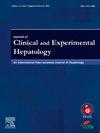DLK1-DIO3位点和miR-379/656簇基因是肝细胞癌患者的潜在诊断和预后标志物:一项系统生物学研究
IF 3.3
Q2 GASTROENTEROLOGY & HEPATOLOGY
Journal of Clinical and Experimental Hepatology
Pub Date : 2024-11-12
DOI:10.1016/j.jceh.2024.102450
引用次数: 0
摘要
背景:肝细胞癌是全球第六大最常见的恶性肿瘤。这凸显了对可用于诊断和预后应用的可靠生物标志物的需求。本研究旨在对delta样非规范Notch配体1- III型碘甲状腺原氨酸脱碘酶(DLK1-DIO3)和miR-379/656簇基因在肝细胞癌中的临床潜力进行分类和表征。方法通过综合系统生物学方法广泛研究DLK1-DIO3基因的临床潜力,并评估与该区域相关的基因的诊断和预后潜力。此外,我们预测了与该位点相关的miR-379/656簇的基因靶点,并确定了基因本体、途径和疾病关联。结果我们报道该区域是肝细胞癌的潜在生物标志物。肿瘤中约有30个聚集的mirna、一个长链非编码RNA和两个编码基因表达不足。受者操作特征分析鉴定出11个具有诊断潜力的集群mirna。生存分析发现母体表达的基因3和miR-379/656簇具有预后意义。此外,随机森林模型预测miRNA簇根据肿瘤、淋巴结、转移(TNM)分期对患者进行分类。此外,过度代表性分析确定了与集群基因靶点相关的几个关键途径、分子功能和生物学过程。结论DLK1-DIO3基因、miR-379/656簇及其靶基因网络可能是肝细胞癌管理和治疗的潜在诊断和预后指标。本文章由计算机程序翻译,如有差异,请以英文原文为准。
Genes of DLK1-DIO3 Locus and miR-379/656 Cluster is a Potential Diagnostic and Prognostic Marker in Patients With Hepatocellular Carcinoma: A Systems Biology Study
Background
Hepatocellular carcinoma is the sixth most common malignancy reported globally. This highlights the need for reliable biomarkers that can be employed for diagnostic and prognostic applications. The present study aimed to classify and characterize the clinical potential of delta like non-canonical Notch ligand 1–type III iodothyronine deiodinase (DLK1-DIO3) and miR-379/656 cluster genes in hepatocellular carcinoma.
Methods
We extensively studied the clinical potential of DLK1-DIO3 genes through a comprehensive systems biology approach and assessed the diagnostic and prognostic potential of the genes associated with the region. Additionally, we have predicted the gene targets of the miR-379/656 cluster associated with the locus and have identified the gene ontology, pathway, and disease associations.
Results
We report this region as a potential biomarker for hepatocellular carcinoma. About thirty clustered miRNAs, a long-non-coding RNA, and two coding genes of the region were underexpressed in tumors. The receiver operating characteristic analysis identified 11 clustered miRNAs with diagnostic potential. Survival analyses identified maternally expressed gene 3 and the miR-379/656 cluster as prognostically significant. Further, the random forest model predicted that the miRNA cluster classifies patients according to Tumor, Node, Metastasis (TNM) staging. Furthermore, overrepresentation analysis identified several key pathways, molecular functions, and biological processes associated with the cluster gene targets.
Conclusion
Our study suggests that DLK1-DIO3 genes, miR-379/656 cluster, and its target gene network might be potential diagnostic and prognostic markers for hepatocellular carcinoma management and therapy.
求助全文
通过发布文献求助,成功后即可免费获取论文全文。
去求助
来源期刊

Journal of Clinical and Experimental Hepatology
GASTROENTEROLOGY & HEPATOLOGY-
CiteScore
4.90
自引率
16.70%
发文量
537
审稿时长
64 days
 求助内容:
求助内容: 应助结果提醒方式:
应助结果提醒方式:


